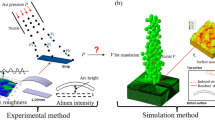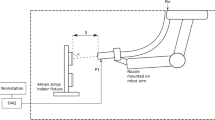Abstract
Peening intensity and coverage are vital measurement outputs to quantify the quality of a peening process in the surface enhancement operation of metal parts. In practice, these parameters can only be measured offline upon process completion, which is not suitable for online tracking and operation. Instead, shot stream velocity can be used as a real-time monitoring parameter to bridge operational inputs to the outputs. As such, a robust and accurate shot stream velocity model is needed for real-time tracking. In this study, we propose a blended practical model for shot stream velocity to address the issues. The model is constructed using a regression algorithm based on the blended candidate functions, which are developed from the experimental data and nature of the particle-air flow inside the system. The obtained model is validated against the experimental data for ASR 70 media type for different operating conditions of the inlet airflow pressure and media flowrate. Calculated velocities are in good agreement with the measurements. In addition, the developed model is applied to predict the shot stream velocity for ASR 230 media type, as well as to evaluate the peening intensity and coverage for different media types under different operating conditions. The predicted results are comparable to the measurement data under the same operating conditions. The maximum relative error of the predicted shot stream velocity and measurement velocity is about 5%, while the maximum error in peening intensity is about ±0.0065 mmA. Furthermore, a single-input and single-output model-based control is developed based on the proposed shot stream velocity model. The developed control system is robust, accurate, and reliable. It implies that the developed model can be used to provide the necessary information, as well as to develop the optimal process control system to improve and accelerate the peening processes for cost and time reduction of actual production.
















Similar content being viewed by others
Data Availability
The authors will make availability of any related data to this manuscript if requested (or data will available on request).
References
Kirk D (1999) Shot peening. International Journal of Aircraft Engineering and Aerospace Technology 77: 349-361. MCB University Press. ISSN 0002-2667.
Burrell NK (1985) Controlled shot peening of automotive components. SAE Trans 94:44–51 www.jstor.org/stable/44721548
Baiker S (2006) Shot peening: a dynamic application and its future. Metal Finishing News. https://books.google.com.sg/books?id=zgVZnQAACAAJ
Marsh KJ (1993) Shot peening: techniques and applications. Engineering Materials Advisory Services Ltd., London
Almen JO, Black PH (1963) Residual stresses and fatigue in metals. McGraw-Hill, Toronto
Anon (1989) Shot peening of metal parts. Military Specification Mil-S-13165c.
Kirk D (2016) Peening intensity: true meaning and measurement strategy. The Shot Peener 3: (3). https://www.shotpeener.com/library/pdf/2016030.pdf
Kirk D (2005) Theoretical principal of shot peening coverage. The Shot Peener 19(2):24–26 https://www.shotpeener.com/library/pdf/2005145.pdf
Franck Petit-Renaud (2018) Optimization of the shot peening parameters. The Shot Peener. https://www.shotpeener.com/library/pdf/2002018.pdf
Miao HY, Larose S, Perron C, Lévesque M (2010) An analytical approach to relate shot peening parameters to Almen intensity. Surface & Coatings Technology 205(7):2055–2066. https://doi.org/10.1016/j.surfcoat.2010.08.105
Champaigne J (1992) Shot peening intensity measurement. The Shot Peener 6(4):1–6 https://www.shotpeener.com/library/pdf/1992082.pdf
Kirk D (2018) Almen strip quality. The Shot Peener 32(3):26–36 https://www.shotpeener.com/library/detail.php?anc=2018034
Kirk D (2015) Verification of peening intensity. The Shot Peener 29(4):28–36 https://www.shotpeener.com/library/detail.php?anc=2015045
Cammett J (2007) Shot peening coverage: the real deal. The Shot Peener 21(3):8–14 https://www.shotpeener.com/library/pdf/2007018.pdf
Kirk D (2014) Quantification of shot peening coverage. The Shot Peener 28(4):22–34 https://www.electronics-inc.com/wp-content/uploads/ QuantificationOfShotPeening Coverage.pdf
SAE J2277 (2013) Shot peening coverage determination. SAE International. https://infostore.saiglobal.com/en-us/Standards/SAE-J-2277-2013-1021238_SAIG_ SAE_SAE_2378326/
Tu F, Delbergue D, Miao HY, Klotz T, Brochu M, Bocher P, Lévesque M (2017) A sequential DEM-FEM coupling method for shot peening simulation. Surf Coat Technol 319:200–212. https://doi.org/10.1016/j.surfcoat.2017.03.035
Zhang Y, Lai F, Qu S, Ji V, Liu H, Li X (2020) Effect of shot peening on residual stress distribution and tribological behaviors of 17Cr2Ni2MoVNb steel. Surface and Coatings Technology 386:125497. https://doi.org/10.1016/j.surfcoat.2020.125497
Gariépy A, Miao HY, Lévesque M (2017) Simulation of the shot peening process with variable shot diameters and impacting velocities. Adv Eng Softw 14:121–133. https://doi.org/10.1016/j.advengsoft.2017.06.011
Nguyen VB, Poh HJ, Zhang YW (2014) Predicting shot peening coverage using multiphase computational fluid dynamics simulations. Powder Technology 256:100–112. https://doi.org/10.1016/j.powtec.2014.01.097
Lin Q, Liu H, Zhu C, Chen C, Zhou S (2020) Effects of different shot peening parameters on residual stress, surface roughness and cell size. Surf Coat Technol 398:126054. https://doi.org/10.1016/j.surfcoat.2020.126054
Seddik R, Bahloul A, Atig A, Fathallah R (2017) A simple methodology to optimize shot-peening process parameters using finite element simulations. Int J Adv Manuf Technol 90:2345–2361. https://doi.org/10.1007/s00170-016-9532-1
Nam YS, Jeon U, Yoon HK, Shin BC, Byun JH (2016) Use of response surface methodology for shot peening process optimization of an aircraft structural part. Int. J. Adv. Manuf. Technol. 87:2967–2981. https://doi.org/10.1007/s00170-016-8690-5
Wang X, Wang Z, Wu G, Gan J, Yang Y, Huang H, He J, Zhong H (2019) Combining the finite element method and response surface methodology for optimization of shot peening parameters. Int. J. of Fatigue 129:105231. https://doi.org/10.1016/j.ijfatigue.2019.105231
Unal O (2016) Optimization of shot peening parameters by response surface methodology. Surf Coat Technol 305:99–109. https://doi.org/10.1016/j.surfcoat.2016.08.004
Kirk D (2002) Curve fitting for shot peening data analysis. The Shot Peener 16(1): 6- https://www.shotpeener.com/library/pdf/2002139.pdf
Kirk D (2007) Generation of air-blast shot velocity. The Shot Peener 20(1):24–30 https://www.shotpeener.com/library/pdf/2016038.pdf
Teo A, Ahluwalia K, Aramcharoen A (2020) Experimental investigation of shot peening: correlation of pressure and shot velocity to Almen intensity. Int J Adv Manuf. Technol 106:4859–4868. https://doi.org/10.1007/s00170-020-04982-y
Nguyen VB, Te B, Teo A, Ahluwalia K, Aramcharoen A, Kang CW (2020) Process model for evaluating the peen velocity in shot peening machine. In: Itoh S., Shukla S. (eds) Advanced Surface Enhancement. INCASE 2019. Lecture Notes in Mechanical Engineering. Springer, Singapore. https://doi.org/10.1007/978-981-15-0054-1_4
Barker B (2005) ShotMeter: a new tool for evaluating shot peening intensity. The Shot Peener 2005:16–30 https://www.shotpeener.com/library/pdf/2005016.pdf
Hribernik A, Bombek G, Markočič I (2003) Velocity measurements in a shotblasting machine. Flow Measure Instrument 14(6):225–231 https://doi.org/10.1016/S0955-5986(03)00041-4
Barker B, Young K, Pouliot L (2005) Particle velocity sensor for improving shot peening process control, Proceedings of ICSP9: 385-391.
Kubler RF, Rotinat R, Badreddine J, Puydt Q (2020) Experimental analysis of the shot peening particle stream using particle tracking and digital image correlation techniques. Exp Mech 60:429–443. https://doi.org/10.1007/s11340-019-00574-4
Ohta T, Ma N (2020) Shot velocity measurement using particle image velocimetry and a numerical analysis of the residual stress in fine particle shot peening. Journal of Manufacturing Processes 58:1138–1149. https://doi.org/10.1016/j.jmapro.2020.08.059
Ohta T, Ma N (2020) Measurement of shot velocity using particle image velocimetry and numerical analysis of residual stress at two shot peening conditions. Mechanical Engineering Journal 7(4): 00152-. https://doi.org/10.1299/mej.20-00152
Motulsky HJ, Ransnas LA (1987) Fitting curves to data using nonlinear regression: a practical and nonmathematical review. FASEB J 1:365–374. https://doi.org/10.1096/fasebj.1.5.3315805
Duggleby RG (1981) A nonlinear regression program for small computers. Analytical Biochemistry 110(1):9–18. https://doi.org/10.1016/0003-2697(81)90104-4
Brunton SL, Proctor JL, Kutz JN (2016) Sparse identification of nonlinear dynamics with control (SINDYc). IFAC-Papers Online 49(18):710–715. https://doi.org/10.1016/j.ifacol.2016.10.249
Kaiser E, Kutz JN, Brunton SL (2018) Sparse identification of nonlinear dynamics for model predictive control in the low-data limit. Proceedings of the Royal Society A: Mathematical, Physical and Engineering Sciences 474 (2219): 20180335, https://royalsocietypublishing.org/doi/abs/10.1098/rspa.2018.0335
Nguyen VB, Teo A, Ba T, Aramcharoen A, Ahluwalia K, Tran SBQ, Kang CW (2021) Advanced model-based controller for cyber-physical shot peening process. Int J Adv Manuf Technol 114:2929–2943. https://doi.org/10.1007/s00170-021-07009-2
Funding
This work is supported by the project entitled “Machine Learning Assisted Control of Shot Peening Process” under Grant number A1894a0032 at Institute of High Performance Computing (IHPC) and Advanced Remanufacturing and Technology Centre (ARTC), A*STAR Singapore.
Author information
Authors and Affiliations
Contributions
Van Bo Nguyen: Developed blended empirical model of shot stream velocity, designed and performed the predictions and control system, developed and performed in silico control scenarios, developed ideas for this paper, analyzed data, wrote original, and revised paper
Augustine Teo: Design experiments, performed experiments, analyzed data, and revised paper
Te Ba: Discussed, analyzed data, and revised paper
Kunal Ahluwalia: Provided some idea on experimental setup, analyzed data, and revised paper
Ampara Aramcharoen: Provide ideas on experimental trials and revised paper
Chang Wei Kang: Managed and provided direction for research development, provided ideas on control design, analyzed data, and revised paper
Corresponding author
Ethics declarations
We confirm that this paper is original and has not been published elsewhere nor is it currently under consideration for publication elsewhere.
Ethics approval
Not applicable
Consent to participate
Not applicable
Consent for publication
Not applicable
Conflict of interest
The authors declare no competing interests.
Additional information
Publisher’s note
Springer Nature remains neutral with regard to jurisdictional claims in published maps and institutional affiliations.
Rights and permissions
About this article
Cite this article
Nguyen, V.B., Teo, A., Ba, T. et al. A blended empirical shot stream velocity model for improvement of shot peening production. Int J Adv Manuf Technol 118, 801–815 (2022). https://doi.org/10.1007/s00170-021-07972-w
Received:
Accepted:
Published:
Issue Date:
DOI: https://doi.org/10.1007/s00170-021-07972-w




